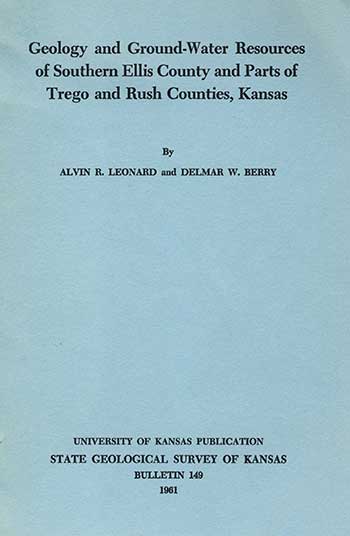Geology and Ground-water Resources of Southern Ellis County and Parts of Trego and Rush Counties, Kansas
By Alvin R. Leonard and Delmar W. Berry
U. S. Geological Survey
Prepared as a part of the program of the Department of Interior for development of the Missouri River basin. The investigation was integrated with the cooperative ground-water program of the United States Geological Survey, the State Geological Survey of Kansas, the Division of Sanitation of the Kansas State Board of Health, and the Division of Water Resources of the Kansas State Board of Agriculture.

Originally published in 1961 as Kansas Geological Survey Bulletin 149. This is, in general, the original text as published. The information has not been updated.
Abstract
This report describes the geography, geology, and ground-water resources of an area about 4 to 13 miles wide and 37 miles long, containing approximately 365 square miles. The climate is subhumid, the mean annual precipitation is 22.90 inches, and the mean annual temperature is 54.7° F. Agriculture is the chief occupation in the area; wheat is the chief crop, but sorghum and alfalfa are grown along the principal streams where the water table is near the surface. Minerals produced in the area are oil, limestone, sand and gravel, silt and clay, and volcanic ash.
The exposed rocks range in age from Late Cretaceous to Recent. The Pleistocene alluvial deposits, which range in age from Nebraskan to Recent, are the principal aquifers in the area. The Dakota Formation (Cretaceous) supplies water for rural domestic and stock use in parts of the area. The shape and slope of the water table are illustrated by a map showing contours of the water table and depth to the water table in wells. Ground water in the Pleistocene alluvial deposits moves downstream and toward the principal streams. Ground water is recharged mainly from local precipitation; ground water is discharged chiefly by seepage into streams and by transpiration by plants.
In most of the area the ground water is suitable for domestic, stock, and municipal use. The water ranges from soft to hard and from moderately to strongly mineralized. Water in the Dakota Formation generally is of the sodium chloride type, has a large amount of dissolved solids, and is moderately hard. Most water from the Pleistocene deposits is of the calcium bicarbonate type and contains moderate to large amounts of dissolved solids. Water from most of the aquifers in the area is rated good to permissible for irrigation.
The hydrologic and geologic field data upon which this report is based include records of 141 wells, chemical analyses of water from 49 domestic and stock wells and from 5 municipal supplies, and logs of 50 test holes, 1 oil well, and 80 jetted test holes.
Kansas Geological Survey, Geology
Placed on web Feb. 4, 2013; originally published March 1961.
Comments to webadmin@kgs.ku.edu
The URL for this page is http://www.kgs.ku.edu/Publications/Bulletins/149/index.html